自动化运维工具——Ansible
- 一、Ansible概述
- 二、ansible 环境安装部署
- 1.管理端安装 ansible
- 2.ansible 目录结构
- 3.配置主机清单
- 4.配置密钥对验证
- 三、ansible 命令行模块
- 1.command 模块
- 2.shell 模块
- 3.cron 模块
- 4.user 模块
- 5.group 模块
- 6.copy 模块
- 7.file 模块
- 8.hostname 模块
- 9.ping 模块
- 10.yum 模块
- 11.service/systemd 模块
- 12.script 模块
- 13. mount 模块
- 14. archive 模块
- 15. unarchive 模块
- 16. replace 模块
- 17.setup 模块
- 四、inventory 主机清单
一、Ansible概述
Ansible是一个基于Python开发的配置管理和应用部署工具,现在也在自动化管理领域大放异彩。它融合了众多老牌运维工具的优点,Pubbet和Saltstack能实现的功能,Ansible基本上都可以实现。
Ansible能批量配置、部署、管理上千台主机。比如以前需要切换到每个主机上执行的一或多个操作,使用Ansible只需在固定的一台Ansible控制节点上去完成所有主机的操作。
Ansible是基于模块工作的,它只是提供了一种运行框架,它本身没有完成任务的能力,真正执行操作的是Ansible的模块, 比如copy模块用于拷贝文件到远程主机上,service模块用于管理服务的启动、停止、重启等。
Ansible其中一个比较鲜明的特性是Agentless,即无Agent的存在,它就像普通命令一样,并非C/S软件,也只需在某个作为控制节点的主机上安装一次Ansible即可,通常它基于ssh连接来控制远程主机,远程主机上不需要安装Ansible或其它额外的服务。
使用者在使用时,在服务器终端输入命令或者playbooks,会通过预定好的规则将playbook拆解为play,再组织成ansible可以识别的任务,调用模块和插件,根据主机清单通过SSH将临时文件发给远程的客户端执行并返回结果,执行结束后自动删除
Ansible的另一个比较鲜明的特性是它的绝大多数模块都具备幂等性(idempotence)。所谓幂等性,指的是无论执行多少次同样的运算,结果都是相同的,即一条命令,任意多次执行所产生的影响均与一次执行的影响相同。比如执行 systemctl stop xxx 命令来停止服务,当发现要停止的目标服务已经处于停止状态,它什么也不会做, 所以多次停止的结果仍然是停止,不会改变结果,它是幂等的,而 systemctl restart xxx 是非幂等的。
Ansible的很多模块在执行时都会先判断目标节点是否要执行任务,所以,可以放心大胆地让Ansible去执行任务,重复执行某个任务绝大多数时候不会产生任何副作用。
二、ansible 环境安装部署
管理端:192.168.30.10
被管理端:192.168.30.20
被管理端:192.168.30.30
1.管理端安装 ansible
yum install -y epel-release //先安装 epel 源
yum install -y ansible
2.ansible 目录结构
/etc/ansible/
├── ansible.cfg #ansible的配置文件,一般无需修改
├── hosts #ansible的主机清单,用于存储需要管理的远程主机的相关信息
└── roles/ #公共角色目录
3.配置主机清单
cd /etc/ansible
vim hosts
[webservers] #配置组名
192.168.80.11 #组里包含的被管理的主机IP地址或主机名(主机名需要先修改/etc/hosts文件)[dbservers]
192.168.80.12
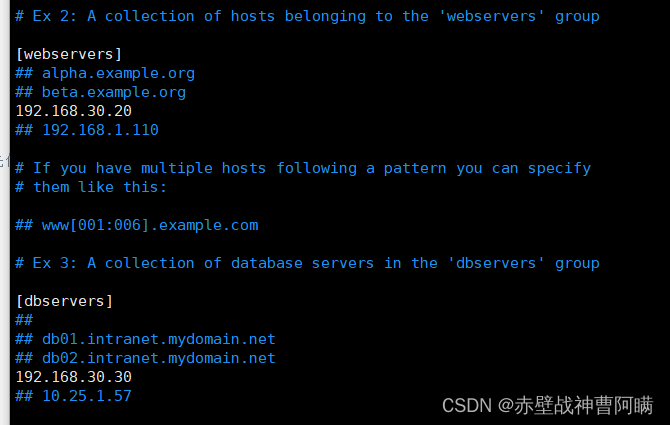
4.配置密钥对验证
ssh-keygen -t rsa -P '' -f ~/.ssh/id_rsayum install -y sshpass
sshpass -p 'abc123' ssh-copy-id -o StrictHostKeyChecking=no root@192.168.30.20
sshpass -p 'abc123' ssh-copy-id -o StrictHostKeyChecking=no root@192.168.30.30
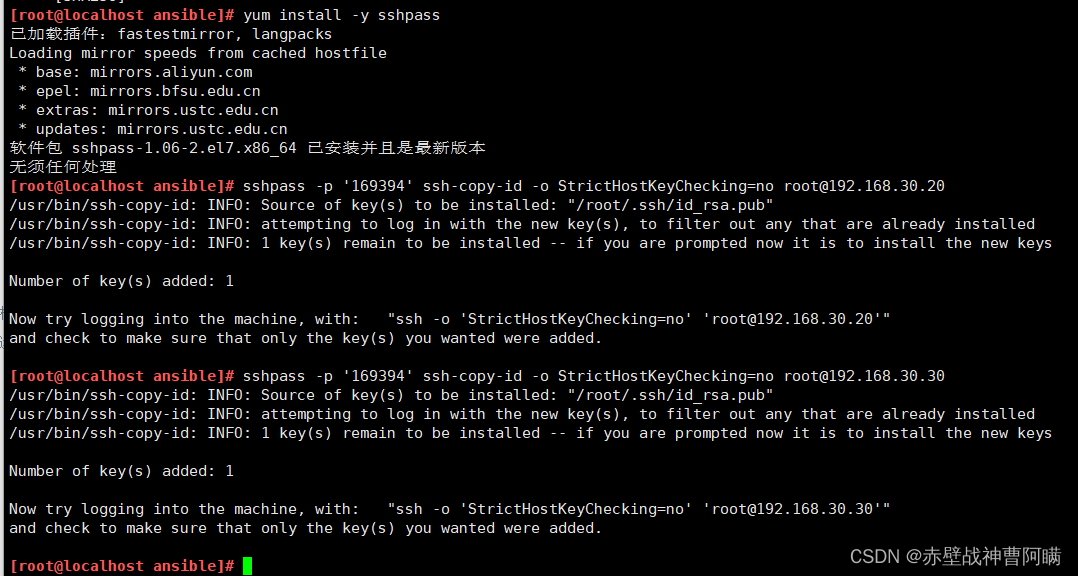
三、ansible 命令行模块
命令格式:ansible <组名> -m <模块> -a <参数列表>
ansible-doc -l #列出所有已安装的模块,按q退出

1.command 模块
在远程主机执行命令,不支持管道,重定向等shell的特性。
ansible-doc -s command #-s 列出指定模块的描述信息和操作动作
ansible 192.168.30.20 -m command -a 'date' #指定 ip 执行 date
ansible webservers -m command -a 'date' #指定组执行 date
ansible dbservers -m command -a 'date'
ansible all -m command -a 'date' #all 代表所有 hosts 主机
ansible all -a 'ls /' #如省略 -m 模块,则默认运行 command 模块
ansible all -m command -a "chdir=/home ls ./"
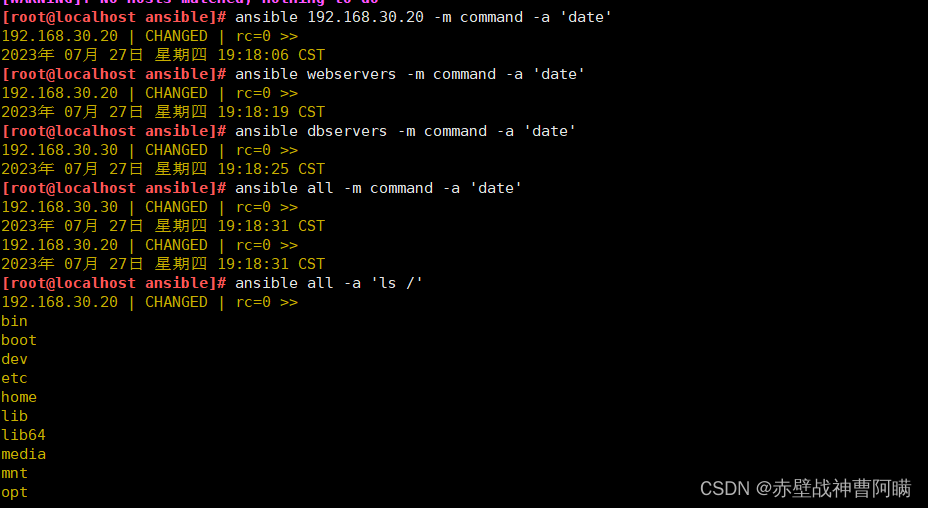
常用的参数:
| 参数 | 说明 |
|---|---|
| chdir | 在远程主机上运行命令前提前进入目录 |
| creates | 判断指定文件是否存在,如果存在,不执行后面的操作 |
| removes | 判断指定文件是否存在,如果存在,执行后面的操作 |
2.shell 模块
在远程主机执行命令,相当于调用远程主机的shell进程,然后在该shell下打开一个子shell运行命令(支持管道符号等功能)
ansible-doc -s shell
ansible dbservers -m shell -a 'echo 123456 | passwd --stdin test"'
ansible dbservers -m shell -a 'echo $(ifconfig ens33 | awk "NR==2 {print $2}") | cut -d " " -f2'
ansible dbservers -m shell -a 'echo $(ifconfig ens33 | awk "NR==2 {print \$2}")'

3.cron 模块
在远程主机定义任务计划。其中有两种状态(state):present表示添加(可以省略),absent表示移除。
ansible-doc -s cron #按 q 退出
常用的参数:
| 参数 | 说明 |
|---|---|
| minute/hour/day/month/weekday | 分/时/日/月/周 |
| job | 任务计划要执行的命令 |
| name | 任务计划的名称 |
| user | 指定计划任务属于哪个用户,默认是root用户 |
ansible webservers -m cron -a 'minute="*/1" job="/bin/echo helloworld" name="test crontab"'
ansible webservers -a 'crontab -l'
ansible webservers -m cron -a 'name="test crontab" state=absent'

4.user 模块
用户管理的模块
ansible-doc -s user
常用的参数:
| 参数 | 说明 |
|---|---|
| name | 用户名,必选参数 |
| state=present丨absent | 创建账号或者删除账号,present表示创建,absent表示删除 |
| system=yes丨no | 是否为系统账号 |
| uid | 用户uid |
| group | 用户基本组 |
| groups | 用户所属附加组 |
| shell | 默认使用的shell |
| create_home=yse丨no | 是否创建家目录 |
| password | 用户的密码,建议使用加密后的字符串 |
| remove=yes丨no | 当state=absent时,是否删除用户的家目录 |
ansible dbservers -m user -a 'name="test01"' #创建用户test01
ansible dbservers -m command -a 'tail /etc/passwd'
ansible dbservers -m user -a 'name="test01" state=absent' #删除用户test01

5.group 模块
用户组管理的模块
ansible-doc -s group
ansible dbservers -m group -a 'name=mysql gid=306 system=yes' #创建mysql组
ansible dbservers -a 'tail /etc/group'
ansible dbservers -m user -a 'name=test01 uid=306 system=yes group=mysql' #将test01用户添加到mysql组中
ansible dbservers -a 'tail /etc/passwd'
ansible dbservers -a 'id test01'
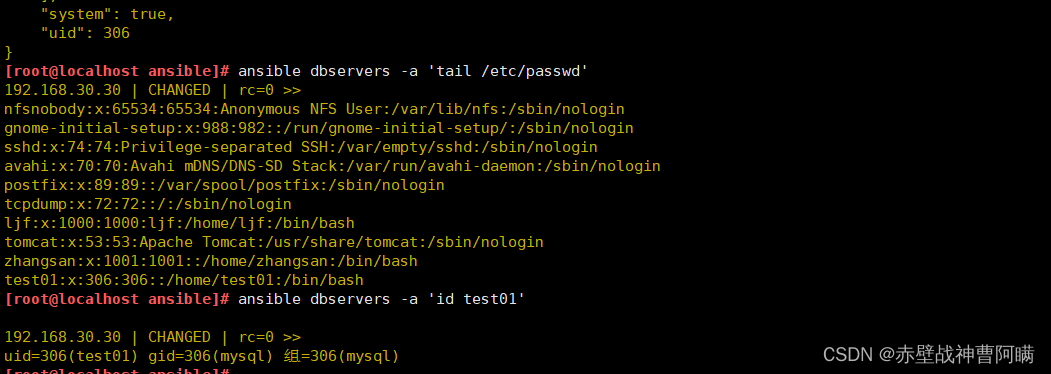
6.copy 模块
用于复制指定主机文件到远程主机的
ansible-doc -s copy
常用的参数:
| 参数 | 说明 |
|---|---|
| dest | 指出复制文件的目标及位置,使用绝对路径,如果源是目录,指目标也要是目录,如果目标文件已经存在会覆盖原有的内容 |
| src | 指出源文件的路径,可以使用相对路径或绝对路径,支持直接指定目录,如果源是目录则目标也要是目录 |
| mode | 指出复制时,目标文件的权限 |
| owner | 指出复制时,目标文件的属主 |
| group | 指出复制时,目标文件的属组 |
| content | 指出复制到目标主机上的内容,不能与src一起使用 |
ansible dbservers -m copy -a 'src=/etc/fstab dest=/opt/fstab.bak owner=root mode=640'
ansible dbservers -a 'ls -l /opt'
ansible dbservers -a 'cat /opt/fstab.bak'ansible dbservers -m copy -a 'content="helloworld" dest=/opt/hello.txt' #将helloworld写入/opt/hello.txt文件中
ansible dbservers -a 'cat /opt/hello.txt'
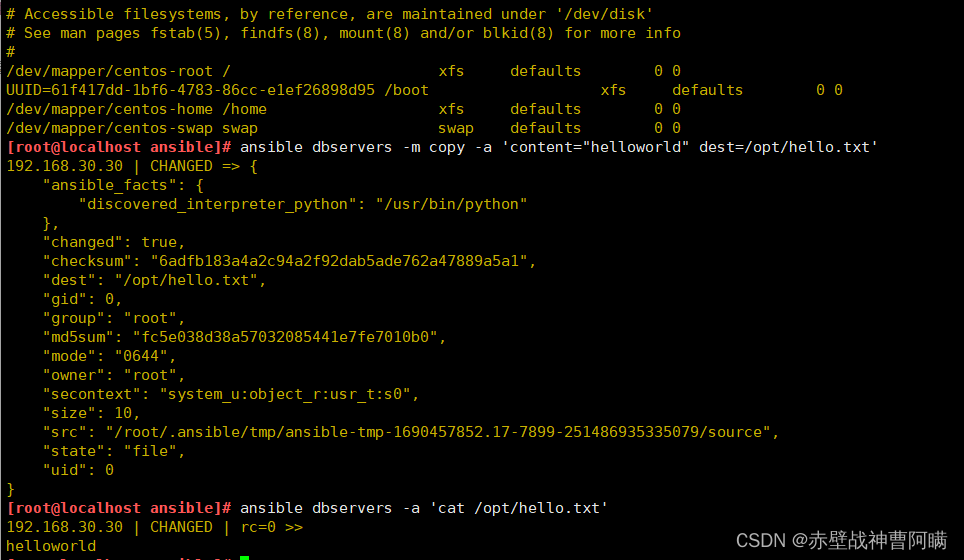
7.file 模块
设置文件属性
ansible-doc -s file
ansible dbservers -m file -a 'owner=test01 group=mysql mode=644 path=/opt/fstab.bak' #修改文件的属主属组权限等
ansible dbservers -m file -a 'path=/opt/fstab.link src=/opt/fstab.bak state=link' #设置/opt/fstab.link为/opt/fstab.bak的链接文件
ansible dbservers -m file -a "path=/opt/abc.txt state=touch" #创建一个文件
ansible dbservers -m file -a "path=/opt/abc.txt state=absent" #删除一个文件
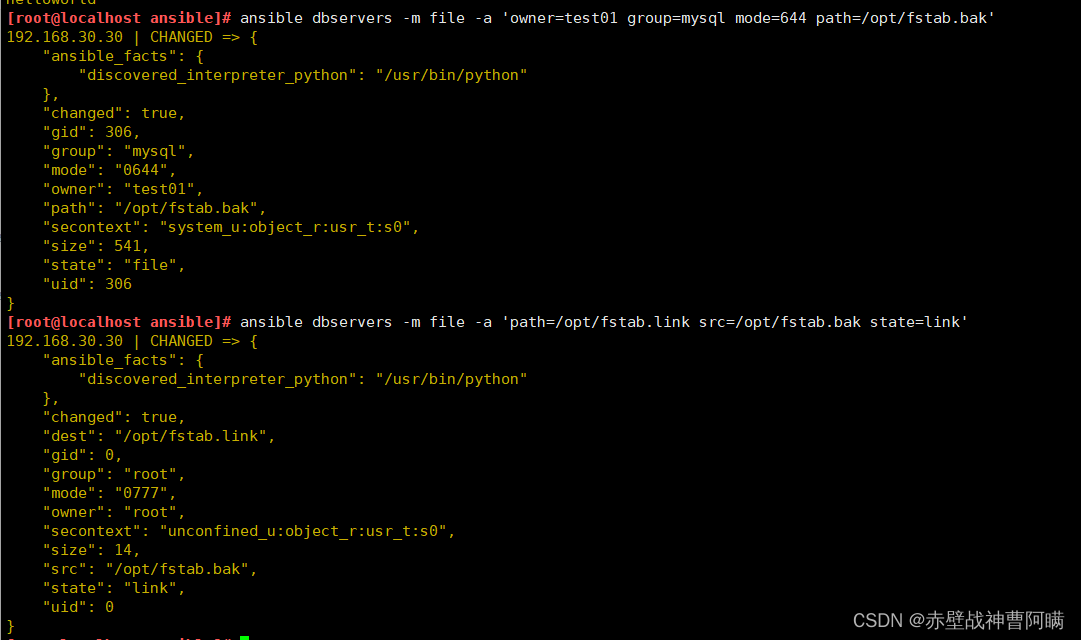
8.hostname 模块
用于管理远程主机上的主机名
ansible dbservers -m hostname -a “name=fxk001”
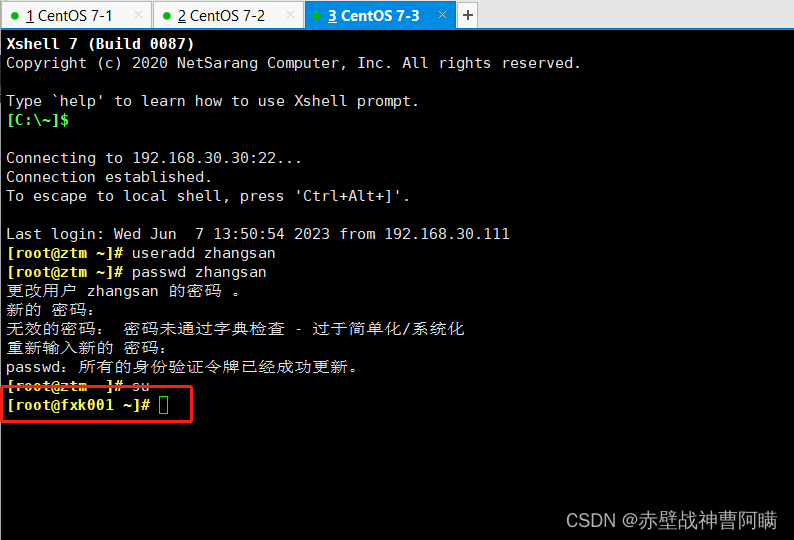
9.ping 模块
检测远程主机的连通性
ansible all -m ping

10.yum 模块
在远程主机上安装与卸载软件包
ansible-doc -s yum
ansible webservers -m yum -a 'name=httpd' #安装服务
ansible webservers -m yum -a 'name=httpd state=absent' #卸载服务
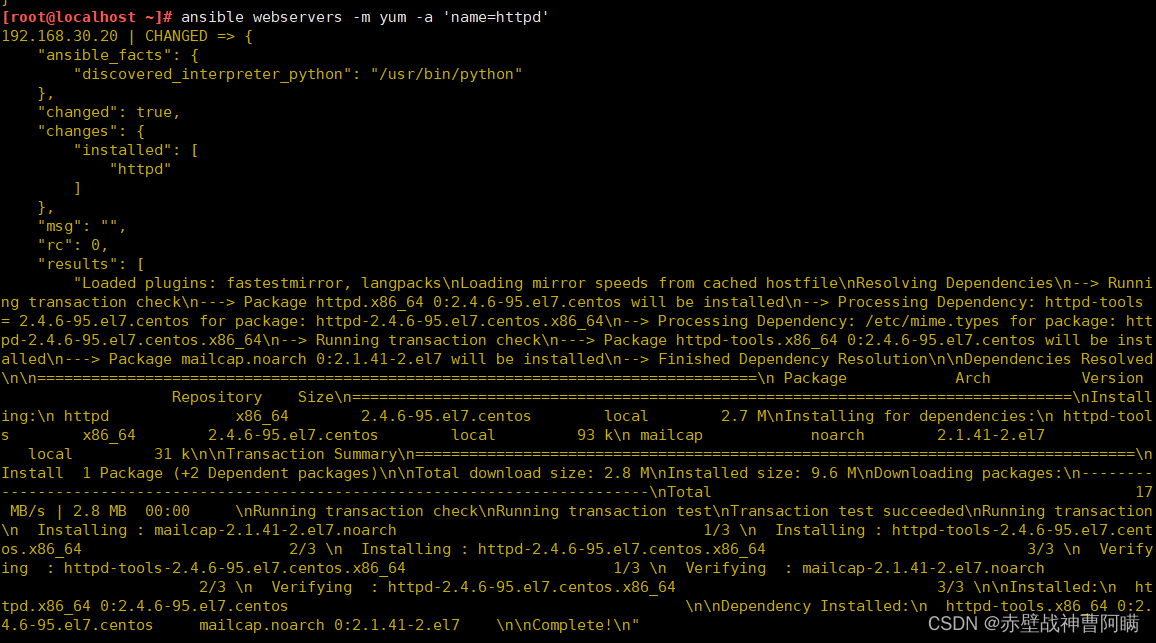
11.service/systemd 模块
用于管理远程主机上的管理服务的运行状态
ansible-doc -s service
常用的参数:
| 参数 | 说明 |
|---|---|
| name | 被管理的服务名称 |
| state=started丨stopped丨restarted | 动作包含启动关闭或者重启 |
| enabled=yes丨no | 表示是否设置该服务开机自启 |
| runlevel | 如果设定了enabled开机自启去,则要定义在哪些运行目标下自启动 |
ansible webservers -a 'systemctl status httpd' #查看web服务器httpd运行状态
ansible webservers -m service -a 'enabled=true name=httpd state=started' #启动httpd服务
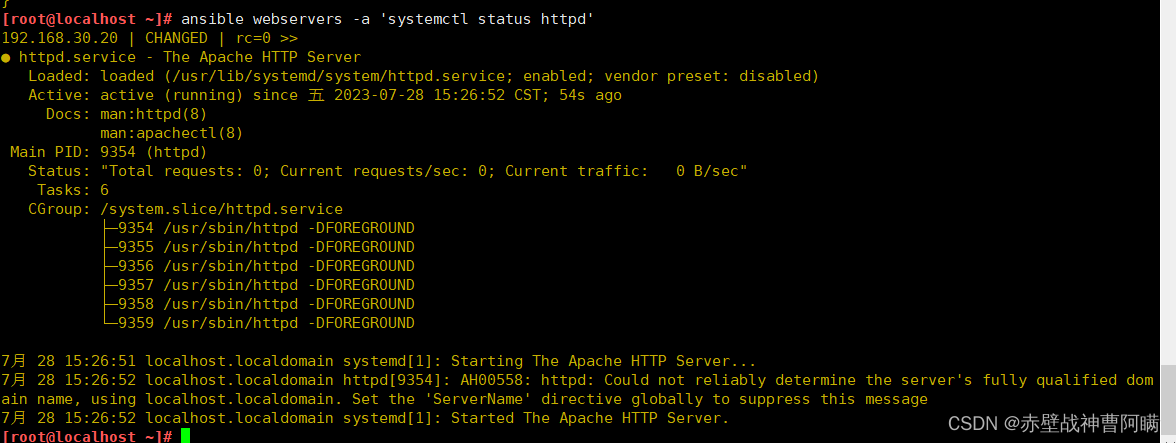
12.script 模块
实现远程批量运行本地的 shell 脚本
ansible-doc -s script
vim test.sh
#!/bin/bash
echo "hello ansible from script" > /opt/script.txtchmod +x test.sh
ansible webservers -m script -a 'test.sh'
ansible webservers -a 'cat /opt/script.txt'vim test02.sh
#!/bin/bash
echo $1 > /opt/test02.txt
echo $2 >> /opt/test02 .txtansible dbservers -m script -a 'test02.sh abc 123!

13. mount 模块
挂载文件系统
ansible-doc -s mount
常用的参数:
| 参数 | 说明 |
|---|---|
| src | 定义挂载设备的路径 |
| path | 定义挂载到哪个目录,必须指定 |
| fstype | 指定挂载文件的系统类型,必须指定,xfs、iso9660、nfs… |
| opts | 定义挂载的参数,defaults、rw、ro… |
| state | 定义挂载的状态,mounted(进行挂载,修改/etc/fstab信息)、absent(永久性卸载,并修改 /etc/fstab信息)、unmounted(临时卸载,不修改/etc/fstab信息) |
ansible webservers -m mount -a 'src=/dev/sr0 path=/mnt state=mounted fstype=iso9660'

14. archive 模块
打包压缩
ansible-doc -s archive
常用的参数:
| 参数 | 说明 |
|---|---|
| path | 必须参数,远程主机上需要被打包压缩的源文件/目录 |
| dest | 打包压缩后的包文件路径(包文件的父目录必须存在);如果包文件已存在,则会被覆盖 |
| format | 指定压缩类型,包括: bz2、gz(默认)、tar、xz、zip |
| remove=yes丨no | 是否删除源文件 |
ansible dbservers -m archive -a "path=/etc/yum.repos.d/ dest=/opt/repo.zip format=zip"
ansible dbservers -m archive -a "path=/opt/abc.txt,/opt/123.txt dest=/opt/abc123.tar.gz format=gz remove=yes"

15. unarchive 模块
解包解压缩
ansible-doc -s unarchive
//常用的参数:
| 参数 | 说明 |
|---|---|
| copy | 默认为 copy=yes ,拷贝的文件从 ansible 主机复制到远程主机,copy=no 表示在远程主机上寻找源文件解压 |
| src | tar包源路径,可以是 ansible 主机上的路径,也可以是远程主机上的路径,如果是远程主机上的路径,则需设置 copy=no |
| dest | 解压后文件的目标绝对路径 |
| remote_src | 和 copy 功能一样且互斥,设置 remote_src=yes 表示文件在远程主机上,设置为 remote_src=no 表示文件在 ansible 主机上 |
#将 ansible 主机的压缩文件拷贝到到远程主机并解压,修改文件所属组和用户
ansible dbservers -m unarchive -a "src=/opt/abc123.tar.gz dest=/root copy=yes"
或者
ansible dbservers -m unarchive -a "src=/opt/abc123.tar.gz dest=/root remote_src=no"#在远程主机解包
ansible dbservers -m unarchive -a "src=/opt/123.tar.gz dest=/root copy=no"
或者
ansible dbservers -m unarchive -a "src=/opt/123.tar.gz dest=/root remote_src=yes"
16. replace 模块
类似于sed命令,主要也是基于正则进行匹配和替换
ansible-doc -s replace
//常用的参数:
| 参数 | 说明 |
|---|---|
| path | 必须参数,指定要修改的文件 |
| regexp | 必须参数,指定一个正则表达式 |
| replace | 替换regexp参数匹配到的字符串 |
| backup=yes丨no | 修改源文件前创建一个包含时间戳信息的备份文件 |
| before | 如果指定,则仅替换/删除此匹配之前的内容,可以和after参数结合使用 |
| after | 如果指定,则仅替换/删除此匹配之后的内容,可以和before参数结合使用 |
| owner | 修改文件用户名 |
| group | 修改文件组名 |
| mode | 修改文件权限 |
vim /opt/test.txt
11 22 33 44 55 66
aa bb cc dd ee ff
1a 2b 3c 4d 5e 6f#匹配 33 并修改为 cc
ansible dbservers -m replace -a "path=/opt/test.txt regexp='33' replace='cc'"
#匹配到任意一个或多个开头的行增加注释
ansible dbservers -m replace -a "path=/opt/test.txt regexp='^(.*)' replace='#\1'"
#取消注释
ansible dbservers -m replace -a "path=/opt/test.txt regexp='^#(.*)' replace='\1'"
#匹配以 a 开头的后面有一个或者多个字符的行,并在前面添加 # 注释
ansible dbservers -m replace -a "path=/opt/test.txt regexp='^(a.*)' replace='#\1'"ansible dbservers -m replace -a "path=/opt/test.txt regexp='3' replace='three' before=cc"
17.setup 模块
facts 组件是用来收集被管理节点信息的,使用 setup 模块可以获取这些信息
ansible-doc -s setup
ansible webservers -m setup #获取mysql组主机的facts信息
ansible dbservers -m setup -a 'filter=*ipv4' #使用filter可以筛选指定的facts信息
四、inventory 主机清单
Inventory支持对主机进行分组,每个组内可以定义多个主机,每个主机都可以定义在任何一个或多个主机组内。
如果是名称类似的主机,可以使用列表的方式标识各个主机。
vim /etc/ansible/hosts
[webservers]
192.168.30.20:2222 #冒号后定义远程连接端口,默认是 ssh 的 22 端口
192.168.30.[2:4]0[dbservers]
db-[a:f].example.org #支持匹配 a~f//inventory 中的变量
Inventory变量名 含义
ansible_host ansible连接节点时的IP地址
ansible_port 连接对方的端口号,ssh连接时默认为22
ansible_user 连接对方主机时使用的用户名。不指定时,将使用执行ansible或ansible-playbook命令的用户
ansible_password 连接时的用户的ssh密码,仅在未使用密钥对验证的情况下有效
ansible_ssh_private_key_file 指定密钥认证ssh连接时的私钥文件
ansible_ssh_common_args 提供给ssh、sftp、scp命令的额外参数
ansible_become 允许进行权限提升
ansible_become_method 指定提升权限的方式,例如可使用sudo/su/runas等方式
ansible_become_user 提升为哪个用户的权限,默认提升为root
ansible_become_password 提升为指定用户权限时的密码(1)主机变量
[webservers]
192.168.30.10 ansible_port=22 ansible_user=root ansible_password=abc123(2)组变量
[webservers:vars] #表示为 webservers 组内所有主机定义变量
ansible_user=root
ansible_password=abc123[all:vars] #表示为所有组内的所有主机定义变量
ansible_port=22(3)组嵌套
[nginx]
192.168.30.40
192.168.30.50
192.168.30.60[apache]
192.168.30.3[0:3][webs:children] #表示为 webs 主机组中包含了 nginx 组和 apache 组内的所有主机
nginx
apache


)



)
![#P0998. [NOIP2007普及组] 守望者的逃离](http://pic.xiahunao.cn/#P0998. [NOIP2007普及组] 守望者的逃离)

——掌控板之三轴加速度6)

:基本定义)







